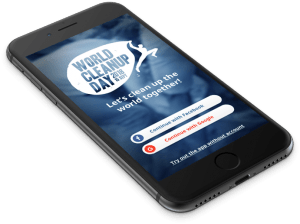Warum wird Mapping benötigt?
Waste Mapping ist die erste Phase vor dem World Cleanup Day. Die Visualisierung der Menge und der Orte des Abfalls hilft dabei:
- Achtung – um Aufmerksamkeit zu gewinnen

- Bewusstsein – generelle Müllblindheit reduzieren
- Commitment – um Aufmerksamkeit zu gewinnen.
- Engagement – um Freiwillige für unser Projekt zu finden
- Budgetierung – zur Berechnung von Ressourcen (Taschen, Handschuhe, Wasser usw.), die für Aufräumarbeiten benötigt werden
- Auswertung – zur Planung der Anzahl der Mitmacher
- Positionierung – um am World Cleanup Day die besten Treffpunkte zu finden
- Lernen – Daten werden zum Erstellen eines weltweiten Abfallindex verwendet!
Wie man mappt?
Daten werden über eine einfach zu verwendende App gesammelt:
 |
 |
Planen eines Mappings?
Bist Du dabei und planst dein eigenes Mapping? Hier sind einige wichtige Dinge zu beachten:
- Beachte das Klima. Da Smartphones zum Mapping verwendet werden, sollte es nicht bei starkem Regen durchgeführt werden.
- Stelle sicher, mit wem Du dich koordinieren musst! Gemeindeverwaltung, Polizei, etc. sollten immer benachrichtigt werden, wenn größere Mapping-Veranstaltungen stattfinden.
- Jeder Freiwillige sollte sein Bestes geben, um die Daten in einer qualitativ guten Form zu erstellen. (z.Bsp.: Bitte lösche alle „Test“ -Marken, die während 24 Stunden nach der Erstellung keinen echten Müll zeigen.)
- Bitte hinterlassen Sie keine Personen- / Firmenlogos (sofern nicht im Müll enthalten 😉 ) auf dem Foto.
- Vergiss nicht, Spaß zu haben!!!
- weitere Informationen gibt es in unseren HowTo’s im Downloadbereich (einfach Registrieren und los geht’s)
Hilfe?
Kontaktieren Sie [email protected], wenn es beim Ausführen der App Probleme gibt oder Fragen zum Mapping entstehen.
ENG:
Why trash mapping is needed?
Waste mapping is the first stage before World Cleanup Day. Visualizing the amount and locations ofwaste helps to gain:
- Attention – to attract media’s and partner’s attention.
- Awareness – to raise awareness in people and reduce general trash blindness.
- Commitment – to attract government’s attention.
- Engagement – to help to find volunteers for World Cleanup Day.
- Budgeting – to help to calculate resources (bags, gloves, water etc.) needed for clean-ups.
- Evaluation – to help to plan the number of people needed to clean up one trash point and for overall cleanup.
- Positioning – to help to find the best meetup locations on World Cleanup Day.
- Learning – data from trash points will be used for creating Waste Index and Keep It Clean! Plan.
Trash points mapped can be seen in:
- App
- Admin Web
- World Waste Platform that collects data from different Waste Mapping apps.
Planning a mapping?
Got excited and planning your own mapping? Here are some important things to consider:
- Mind the climate. Since smartphones are used for mapping, it cannot be done while heavy rain.
- Make sure whom you have to co-ordinate with! Your local government, in times also police, should always be notified when there are bigger mapping events taking place.
- Each volunteer should give her/his best to keep the data in a good shape. Please delete all the “test” trash points that are not showing real trash during 24h from creation.
- Please don’t leave any people/companies logos (if not included in the trash pile) on the photo.
- Don’t forget to have FUN!!!

